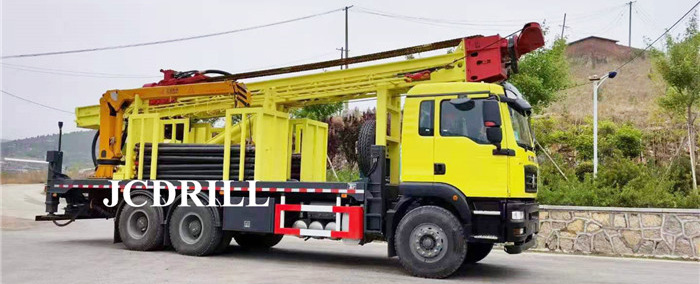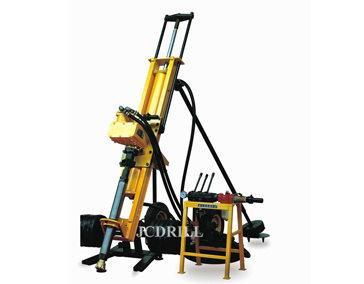Types of Drilling Rigs
Water Well Drilling Machine
In a broad sense, drilling rigs can be classified as fixed or mobile. These terms describe the ability of a drilling rig to leave the drilling site quickly when necessary. This classification is broad and there is little definition of each rig type.
The land and marine classifications provide a more logical grouping of rig types. While there are more types of offshore rigs to choose from, there are more land rigs in use today.
Cable tool rigs. Cable tool rigs have played a key role in the history of the drilling industry. Although not in widespread use today, these rigs accounted for about 20% of all wells drilled in the United States in 1961. Many shallow Ohio, West Virginia, and Pennsylvania wells (3,000 feet) are currently drilled by cable tool rigs.
Drilling with a cable tool rig is accomplished by lifting a special drill bit and placing it into the formation. The drill column consists of a drill bit, a drill pipe, a shocker, and a rope sleeve for attaching the tool to the drilling tool.
Portable (wheel-mounted)
Cable tools
Rotary drill rigs
Standard derricks
Conventional
Land rigs. The most common land rigs use standard derricks, truck-mounted derricks, or component rigs. The American Petroleum Institute provides various documents related to these rig types, including API Specifications 4E and 8A and Standards 4A and 4D.
Standard derricks. The oldest rotary rigs in the drilling industry use standard derricks. Derricks are built at the drilling site prior to drilling and are usually removed before being moved to the next location. Many times, the derrick is left above the well after production begins in case it needs to be repaired.
Early in its history, the standard derrick was an advancement in cable tool drilling rigs because it could be designed with enough strength and height to run longer casing joints and pull two, three or even four pipe joints. Combination derricks with integral lift rather than integral lift.
Rock Blasting Drilling Rig
Piecemeal construction has replaced standard derricks. Standard derricks take too long to set up and take down. In addition, combination derricks typically have fewer failures than derricks built and disassembled for each well.
Portable rigs. Portable rigs are often thought of as truck-mounted units. The truck chassis contains the derrick, winch, and mud pump. A major advantage of portable rigs is the short setup and teardown time and the low truck rental requirements. Portable rigs are often used for workover operations and when drilling to depths of approximately 10,000 feet. These rigs can be used 8, 12, or 24 hours per day.
Portable units for drilling are typically limited to light-duty work. Where applicable, the unit is usually the most cost-effective rig.
Since most of the world's wells are drilled to depths of less than 8,000-10,000 feet, portable rigs play an important role in drilling operations.
Care must be taken when planning wells that are near the upper limit of the portable rig's capacity. For example, if a 3'/z- or 4-in drills a well to 10.000 feet, it will not deform a large portable rig. A drill pipe is used. However, if 23.0 lb/ft of casing must be run to 10,000 ft, then the total casing load (230,000 tb) does not provide an adequate safety factor associated with derrick capacity. While short-term economics may suggest using a portable rig rather than a larger, more expensive conventional rig, a larger rig may be more economical in the long run if drilling problems arise.
Conventional rigs. Conventional rigs are often considered component rigs in which key components are so large that they cannot be transported on a single truck chassis. These rigs have depth ratings ranging from 6,000 feet to 35,000 feet. Conventional rigs typically operate 24 hours a day.
Marine Rigs. Drilling rigs used offshore are termed marine rigs. A common grouping system for marine rigs is based on the bottom support of the rig on the seafloor. A bottom-supported rig rests on the seafloor or on pads built on the seafloor.





评论
发表评论